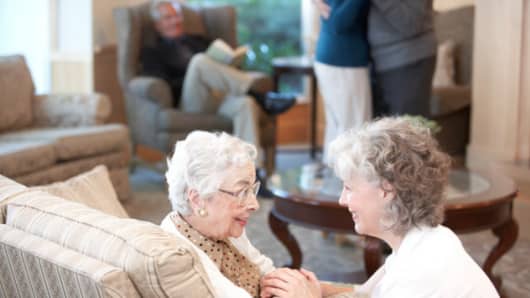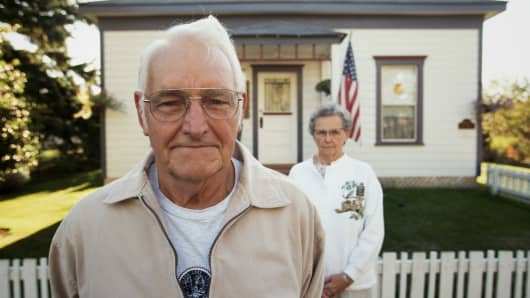For millions of baby boomers, planning their own retirement has taken a backseat to helping their aging parents navigate the golden years. Often referred to as the sandwich generation, this group is tasked with caring for seniors while tending to growing children.
A general lack of preparedness coupled with fears ranging from isolation and loneliness to neglect and “who’s going to pay for this?” have left many trying to shoulder the burden on their own.
According to the 2010 U.S. Census Bureau, 4.4 million homes had three generations or more living under one roof — a 15 percent increase from 2008. That number is continuing to grow, says Marion Somers, who has spent the past four decades as a geriatric care manager and is currently on a cross-country tour educating Americans about the importance of planning ahead for long term care.
While nursing homes and assisted living facilities can offer round-the-clock care for elders and take a bit of pressure off already-harried boomers, neither is cheap nor, for some, all that desirable.
Home Is Where the Heart Is
There’s no place like home for the senior set, according to an AARP survey. Ninety percent of people over age 65 said they want to stay in their home as long as possible — a figure that has remained constant for the last four years.
Making that wish come true can be complicated and costly, but with a growing number of in-home care providers and new technological advancements, more options are available than in past generations.
Paul Hogan founded Home Instead Senior Care in 1994. With more than 900 offices offering nonmedical senior care and companionship services, Hogan says one of the biggest obstacles caregivers face is lack of awareness of the in-home services that exist.
“When we started in the early 1990s there were two options: It was going to be the nursing home or my daughter’s home,” Hogan says. “Now there’s a whole proliferation of options that have evolved over the last 20 years, and very few people know what they are and how much they cost.”
Hogan says families faced with the challenge of making a decision, often under pressure, have a tendency to underestimate the expense of nursing homes and overestimate the cost of in-home care, often by as much as 30 percent, leading them to make poor choices or not recognize the affordability of nonmedical at-home care.
Somers advises caregivers to do their homework carefully when considering the gamut of options. She points out that aides can cost as little as $10 an hour in some parts of the country and as much as $27 an hour in other areas.
“What if you need a nurse to administer insulin shots?” she asks. “That can range anywhere from $75 to $175 depending on where you live.”
A Genworth 2012 Cost of Care Survey reveals private or semi-private rooms in a nursing home average upwards of $200 per day nationally, or approximately $6,000 per month, while the average assisted living facility commands $3,300 per month. Those in the market for in-home nonmedical care can expect to pay close to $19 per hour on average nationally.
Jeff Bevis, who is chief executive officer of FirstLight Home Careand is also caring for his 88-year-old father-in-law, says the need for in-home nonmedical care is “skyrocketing” quarter after quarter.
“There’s a major level of desire and interest among seniors to remain in their own home no matter what,” he says.
Bevis pegs the in-home nonmedical care business as a $70 billion industry and one that is likely to triple over the next several decades as the senior population explodes.
The number of people age 65 and older will more than double between 2010 and 2050 to 88.5 million or 20 percent of the population; likewise, those 85 and older will rise three-fold, to 19 million, according to the U.S. Census Bureau.
Bevis explains that modern technology can help create a middle ground offering a cost-effective solution that allows seniors to maintain their independence and dignity while still staying safe in the comfort of their own homes.
'Granny Pods' and More
Web portals that enable the client, family members and the caregiver to go in and see notes on services or care provided that day are one option. Bevis also touts the importance of personal emergency response systems that not only provide peace of mind knowing help is available in a crisis but can also relay vital signs wirelessly to a doctor’s office.
“Family members can go in and see what mom’s heart rate was today,” Bevis says. “If mom or dad would fall, their chance of survival drops dramatically if they’re not found within the first few hours. The New England Journal of Medicine released a study that was done two years ago that was pretty eye-opening in that regard. The personal emergency response systems can be a lifesaver.”
Somers said seniors can wear bands that monitor the body’s rhythms and movements throughout the day and will detect if a typical pattern has been disrupted and issue an alert if activity is unusual.
Keeping Grandma as Close as Your Own Backyard, Literally
Other modern innovations include the MEDCottage, also known as “the Granny pod.” A tricked-out tree house for the elderly, the 284-square-foot structure features many of the bells and whistles of a nursing home — including rubber flooring — but sits in a caregiver’s backyard and, with its own kitchen and bathroom, runs off the main residence’s power and water supply.
The idea came to Salem, Va.-based Rev. Ken Dupin, as he was working on his Ph.D. Though he didn’t complete his dissertation, Dupin ran with the idea and is currently chief executive officer of N2Care, maker of MEDCottage.
“Our whole focus is to promote family-managed care,” Dupin says. “We’re all about putting the family back into this stage of life and as we researched it, there didn’t seem to be a lot of good options as the one we came up with.”
After seven years in development, the first residential MEDCottage was placed in Fairfax, Va. last month.
“What’s unique is we have a created a dashboard that gives the caregiver access to literally every part of the MEDCottage including the ability to track blood pressure, heart rate, weight, temperature, glucose and all those things, as well as the structure itself,” Dupin explains.
The cyber-chic shanty also includes something called “Feet Sweep,” a camera system that monitors 12 inches off the floor in case a loved one has fallen. A caregiver can also remotely check in to see whether or not the elder has taken his or her medication.
So how much does this high-tech hideaway cost? Dupin explains that the original model runs about $85,000 but distributors are coming out with new offerings that are “not nearly as fancy” and will be priced in the neighborhood of $50,000.
Another advantage, Dupin points out, is that unlike a nursing home or an assisted living facility, MEDCottage is an asset.
“The distributor will purchase it back after a year or two years at a negotiated price,” he says. “Everything the MEDCottage does is to promote family-managed care. There are no subscription fees or monitoring services, everything goes back to the family.”
Competition is popping up for this modern alternative to the mother-in-law suite, Dupin says, as two modular home manufacturers have come out with their own versions.
Nationwide Home has the Care Cottage and Clayton, a Berkshire Hathaway company, has come out with something called the iHouse.
“Definitely there is a horizon for this concept,” Dupin says.
Be Prepared
Another hurdle baby boomers have to overcome is the suddenness of the need for care.
“Three days ago Dad was golfing and today he’s in the hospital because last night he had a stroke and he’s incapacitated,” says Hogan of Home Instead. “They never had the conversation or took the time to discuss what Dad’s preferences were for care so therefore this creates a huge amount of guesswork for that primary family caregiver.”
To combat this, Hogan devised the “40-70 Rule” aimed at bridging the communication gap between generations and fostering discussions — when one is their 40s and the other is their 70s — about how, when and where aging parents wish to receive care. Hogan said these issues are often so uncomfortable and overwhelming that he felt compelled to author a booklet, designed to help struggling caregivers.
Even with technological advancements, providing for the health and safety of aging parents is no small task. Having that conversation earlier and before a crisis occurs can make growing old gracefully a bit more manageable for everyone involved.



